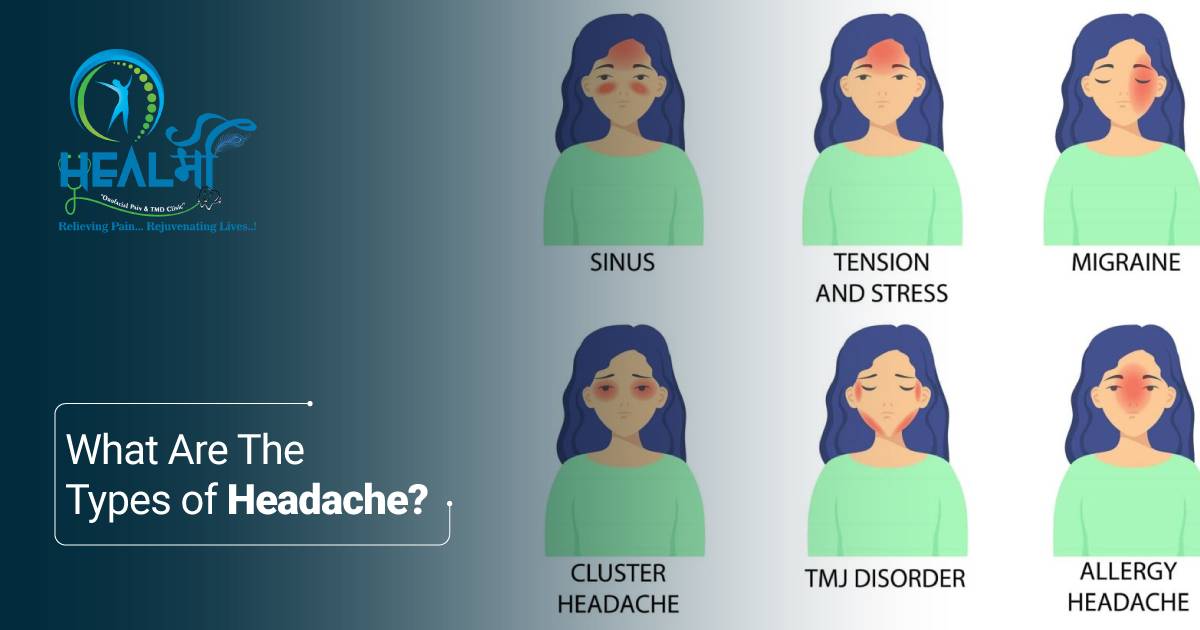What Are The Types of Headaches?
Home
What Are The Types of Headaches?

Home
What Are The Types of Headaches?


Headaches! Even the word can make your head spin, right? We’ve all had those days when our head feels like it’s caught between a drum and a rock concert. Sometimes it’s a dull ache, other times it’s sharp and pounding. If you are searching for Headache Treatment in Ahmedabad, then visit Healme Pain Clinic.
But here’s the real thing: not all headaches are the same. There are so many different kinds of headaches, and each type has its own cause, symptoms, and way of ruining your day. We’ll dissect each of them in the most human terms possible, since no one needs medical jargon on top of a head that feels like it’s spinning around.
You know your head feels like that tight, band-like sensation after a hectic day at work? That’s a tension headache. It’s among the most common types of headache, frequently due to stress, anxiety, poor posture, or not eating (such as when you miss lunch).
It typically begins as a dull, constant pressure on both sides of the head. Some also experience it in their neck or shoulders. Unlike migraines, tension headaches generally aren’t accompanied by nausea or vision symptoms. They are less like a fire alarm that is blaring out and more like your brain’s way of saying, “Hey, can we take a break here?”
A warm shower, a quick nap or taking a break from your screen can help relieve it.
If you’ve ever had a migraine, you know it’s not just an ordinary headache but a full-blown event. Migraines are among the most debilitating headaches and can last from a few hours to several days.
The pain is frequently pulsating and typically on one side of the head. You could be sensitive to light, sound or even smell. For some people, visual changes called an “aura” precede the pain, flashing lights or blurry vision, for example.
Migraines can be set off by stress, hormonal changes, skipped meals, insufficient sleep and even some foods (chocolate lovers beware). Reclining in a dark, quiet room and hydrating frequently are also beneficial. But if your migraines are persistent, you might want to see a doctor.
Now, those are few and far between but incredibly painful. Cluster headaches are among the most severe types of headache, characterised by a stabbing or burning pain behind one eye.
They generally come in “clusters” — that is, as a series of attacks over weeks or months, separated by periods with no headaches. The eye can be red, teary, or even slightly swollen, and the nose may feel stuffy on that side.
They’re short but nasty; they can go from 15 minutes to a few hours. The cause isn’t apparent, unfortunately, but it seems to involve abnormal activity in the brain’s hypothalamus. The frequency and severity of them may be lessened by using oxygen therapy or medication.
If your head feels heavy and your face hurts, particularly the area around your eyes or over the bridge of your nose or in your cheeks, you may be suffering from a sinus headache.
Of the general headaches, this type is associated with sinus infections or allergies, which result in inflamed and congested sinuses. You may also have a stuffy nose, swollen face, or slight fever
A warm compress over your sinuses, or inhaling steam from a pot of hot (but not boiling) water, can help relieve the pressure. Drinking plenty of water and using saline sprays can also be beneficial. But if the symptoms linger, it might not be a sinus headache at all — it could be a migraine masquerading as one.
Ironically, frequent use of painkillers for headaches can lead to more headaches. Weird, right? This is something called a rebound headache or medication-overuse headache.
As your body gets used to some pain relievers, it can depend on them. Once they wear off, the pain seems to immediately return — if not worse than before.
The best solution? Very gradually: Tapering off with your doctor and other ways to manage pain, like better sleep or hydration or relaxation techniques.
Ladies, this one’s for you. Fluctuations in hormones — during menstruation, pregnancy and menopause — are a common headache trigger, particularly for migraines. These kinds of headaches are associated with declines in estrogen levels.
They tend to appear just before or during your period, and they feel like regular migraines, though occasionally less severe. Being mindful of your cycle and trying to regulate patterns of sleep, diet, and hydration can all help keep them in check.
Have you ever found yourself with a pounding head after exercising? That’s an exertion headache. It tends to strike during or after vigorous physical activity, like running, lifting weights or maybe sneezing too forcefully.
This occurs when there is a sudden increase in the blood flow to your brain. Though they usually resolve on their own, it is a good idea to stay hydrated and to warm up properly before exercising in order to avoid them.
Headaches may seem ordinary, but there’s so much these common afflictions can tell us about what’s happening inside your body. Knowing what types of headaches there are, with experts at Healme Pain Clinic, can help you decide what’s causing yours and how to treat it more effectively.
Right, stress, dehydration, not enough sleep or unchecked hormones: I remind myself to listen to my body. So the next time your head begins to throb, take a second thought before simply popping that painkiller. Breathe, clear your head and give good attention to your noggin.
Because let’s face it, a cool head is the best kind of head.